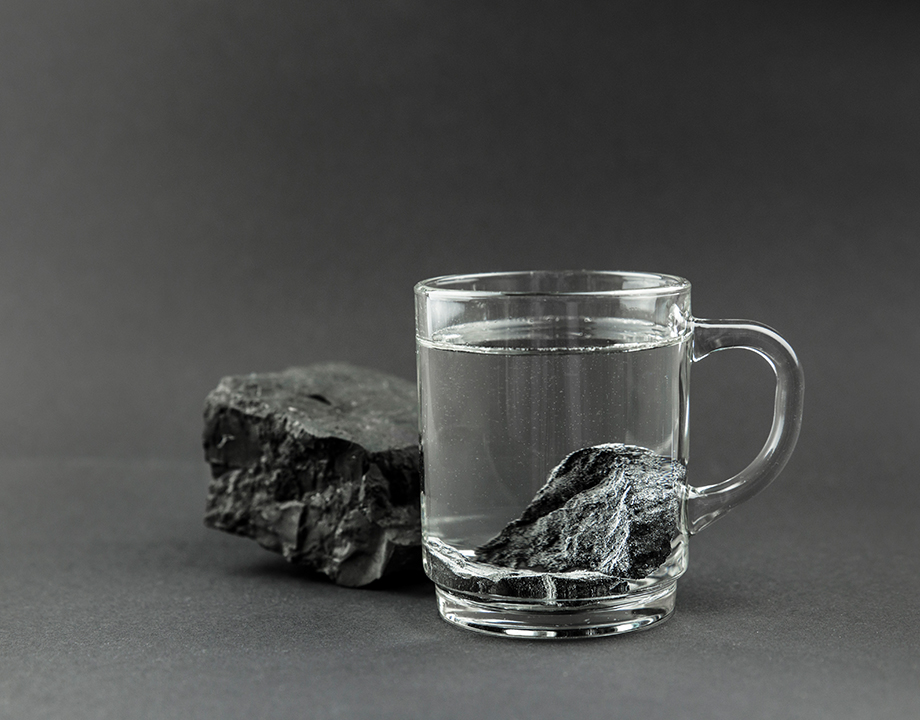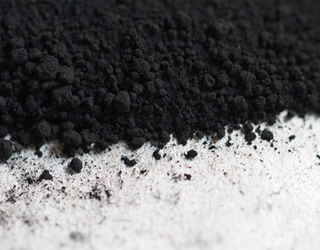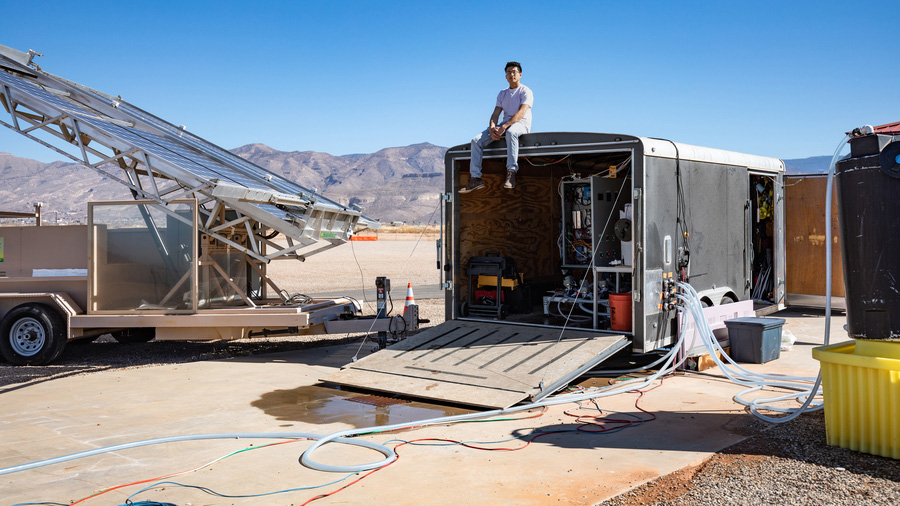How Coal the “Black Gold” Makes Green Water
How Coal the “Black Gold” Makes Green Water


Crush organic material under layers of dirt for a few million years, and you get a product you can burn for fuel or use to desalinate water.
Population growth, urbanization, pollution, and climate change are making water scarcity a growing issue all over the planet. By 2050, some five billion people will have to grapple with water shortages, according to a recent United Nations report. But now there’s a material that may change all that. Cheap and abundant, it has the potential to desalinate water on a massive scale. We’ve been using it for other purposes for a long time—it’s none other than that sedimentary carbon rock, known as coal.
Coal is famously black, so it can absorb nearly 100 percent of the electromagnetic radiation that hits it. That means that any water it might contain will evaporate quickly. Usually, of course, coal is not a natural retainer of water. So, researchers out of Saudi Arabia’s King Abdullah University of Science and Technology decided to add some porosity.
“One way is to grind it, make particles of the coal—or any carbonized material—then homogeneously compress them,” said Valerio Mazzone, a postdoctoral research fellow at the University of Zurich and first author of the paper “Clean Carbon Cycle via High-Performing and Low-Cost Solar-Driven Production of Freshwater,” which appeared in Advanced Sustainable Systems this September. “The funny thing is, the procedure is the same as making bricks for barbecue.”
Recommended for You: Engineers Tackle Water Shortages
But the purpose of these bricks is to hold water, not fire. The coal can draw water into it with its newfound porosity using capillary action. To keep the water from cooling the coal, it sits atop a thermally insulating float platform. Cotton fibers embedded in the coal extend below the platform, bringing water to the coal block.
In their current arrangement, the water condenses on a transparent pyramidical cover as it evaporates, then runs down into a reservoir at the bottom. The salt and other impurities that collect on the coal and cotton threads surface can just be wiped away. And the system works with any coal. In fact, it works with any black carbon that can be made into powder. The researchers even tried ground coconut shells. But coconuts aren’t as plentiful as coal.
“Coal has advantages because it’s inexpensive,” said Andrea Fratalocchi, a professor of electrical and computer engineering at KAUST and co-author of the paper. As it happens, the countries that produce the most coal also receive the most significant amount of that other essential ingredient for coal-powered desalination: sunlight. “You need to have sun. Countries like Saudi Arabia, with ten hours of sun every day, 365 days a year, are best,” Fratalocchi said. The system won’t work so well in Anchorage.
Thankfully, the mining of coal, the shipping of coal, and even the production of coal briquettes are all systems and technologies firmly in place worldwide. So coal-freshened water is not likely to cost more than water made potable with reverse osmosis. “With this system, if you just look at the cost of producing, it’s comparable,” Fratalocchi said. “But if you put in the cost of health care and the species that are disappearing, then it’s going to be a no-brainer solution.”
Editor's Pick: Solar Desalination System Delivers High Energy Output
The desalinating coal Fratalocchi, Mazzone, and their team produced was a 20-centimeter by 20-centimeter slab of coal that turned Red Sea water into drinking water at a rate of 2.2 liters per square meter per hour. But the system can work at any scale. A 16 by 16 centimeter square of carbonized compressed powder could provide enough water for a single household, whereas much larger chunks, or many smaller ones, working together could produce enough water for entire municipalities. The researchers are currently working with a company developing a more extensive pilot system for brackish water in Brazil.
In addition to the benefit of cheaply and cleanly producing drinkable water, Fratalocchi hopes that desalinating water with his system will also slow the burning of coal by diverting it to this greener purpose. “Our main idea is to convince the big producers of coal to divest from new power plants,” he said. “I hope that we find a win-win with the coal companies: you can keep your job with coal, and you can fight climate change with coal.”
Michael Abrams is a technology writer based in Westfield, N.J.
Coal is famously black, so it can absorb nearly 100 percent of the electromagnetic radiation that hits it. That means that any water it might contain will evaporate quickly. Usually, of course, coal is not a natural retainer of water. So, researchers out of Saudi Arabia’s King Abdullah University of Science and Technology decided to add some porosity.
“One way is to grind it, make particles of the coal—or any carbonized material—then homogeneously compress them,” said Valerio Mazzone, a postdoctoral research fellow at the University of Zurich and first author of the paper “Clean Carbon Cycle via High-Performing and Low-Cost Solar-Driven Production of Freshwater,” which appeared in Advanced Sustainable Systems this September. “The funny thing is, the procedure is the same as making bricks for barbecue.”
Recommended for You: Engineers Tackle Water Shortages
But the purpose of these bricks is to hold water, not fire. The coal can draw water into it with its newfound porosity using capillary action. To keep the water from cooling the coal, it sits atop a thermally insulating float platform. Cotton fibers embedded in the coal extend below the platform, bringing water to the coal block.
In their current arrangement, the water condenses on a transparent pyramidical cover as it evaporates, then runs down into a reservoir at the bottom. The salt and other impurities that collect on the coal and cotton threads surface can just be wiped away. And the system works with any coal. In fact, it works with any black carbon that can be made into powder. The researchers even tried ground coconut shells. But coconuts aren’t as plentiful as coal.
“Coal has advantages because it’s inexpensive,” said Andrea Fratalocchi, a professor of electrical and computer engineering at KAUST and co-author of the paper. As it happens, the countries that produce the most coal also receive the most significant amount of that other essential ingredient for coal-powered desalination: sunlight. “You need to have sun. Countries like Saudi Arabia, with ten hours of sun every day, 365 days a year, are best,” Fratalocchi said. The system won’t work so well in Anchorage.
Thankfully, the mining of coal, the shipping of coal, and even the production of coal briquettes are all systems and technologies firmly in place worldwide. So coal-freshened water is not likely to cost more than water made potable with reverse osmosis. “With this system, if you just look at the cost of producing, it’s comparable,” Fratalocchi said. “But if you put in the cost of health care and the species that are disappearing, then it’s going to be a no-brainer solution.”
Editor's Pick: Solar Desalination System Delivers High Energy Output
The desalinating coal Fratalocchi, Mazzone, and their team produced was a 20-centimeter by 20-centimeter slab of coal that turned Red Sea water into drinking water at a rate of 2.2 liters per square meter per hour. But the system can work at any scale. A 16 by 16 centimeter square of carbonized compressed powder could provide enough water for a single household, whereas much larger chunks, or many smaller ones, working together could produce enough water for entire municipalities. The researchers are currently working with a company developing a more extensive pilot system for brackish water in Brazil.
In addition to the benefit of cheaply and cleanly producing drinkable water, Fratalocchi hopes that desalinating water with his system will also slow the burning of coal by diverting it to this greener purpose. “Our main idea is to convince the big producers of coal to divest from new power plants,” he said. “I hope that we find a win-win with the coal companies: you can keep your job with coal, and you can fight climate change with coal.”
Michael Abrams is a technology writer based in Westfield, N.J.






